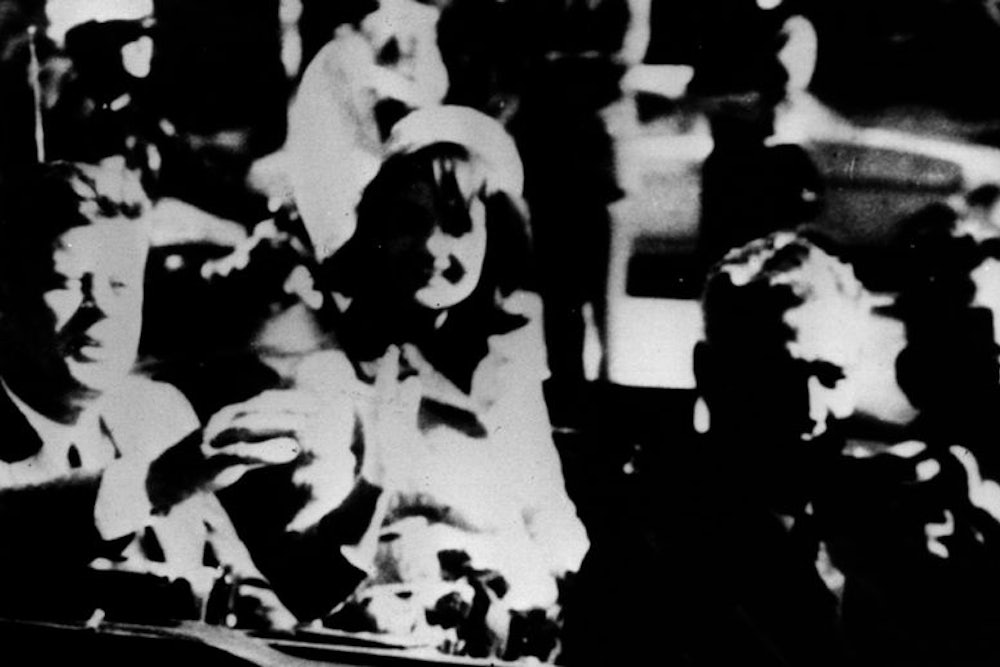"Commentary of an Eyewitness," by Richard Dudman
The New Republic, December 21, 1963
To read more of The New Republic's coverage of the Kennedy Assassination, click here.
I witnessed President Kennedy’s assassination and the slaying of the accused assassin two days later. Three circumstances—the entry wound in the throat, the small, round hole in the windshield of the Presidential limousine, and the number of bullets found afterward—suggested that there had been a second sniper firing from a point in front of the automobile.
The throat wound puzzled the surgeons who attended Mr. Kennedy at Parkland Memorial Hospital when they learned how the Dallas police had reconstructed the shooting. Dr. Robert McClelland, one of the three doctors who worked on the throat wound, told me afterward that they still believed it to be an entry wound, even though the shots were said to have been fired almost directly behind the President. He explained that he and his colleagues at Parkland saw bullet wounds every day, sometimes several a day, and recognized easily the characteristically tiny hole of an entering bullet, in contrast to the larger, tearing hole that an exiting bullet would have left.
A few of us noticed the hole in the windshield when the limousine was standing at the emergency entrance after the President had been carried inside. I could not approach close enough to see on which side was the cup-shaped spot that indicates a bullet has pierced the glass from the opposite site.
As for the number of bullets, although all who heard them agreed there were three shots, authorities repeatedly mentioned four bullets found afterward—one found in the floor of the car, a second found in the President’s stretcher, a third removed from Governor Connally’s left thigh, and a fourth said to have been removed from President Kennedy’s body at the Naval Hospital in Bethesda. On the day the President was shot, I happened to learn of a possible fifth. A group of police officers were examining the area at the side of the street where the President was hit and a police inspector told me they had just found another bullet in the grass. He said he did not know whether it had anything to with the assassination.
With these circumstances in mind, I returned to the scene to see where a shot from ahead of the President’s car might have originated. From the stretch traveled by the car when the shots were fired, a large sector in front is taken up by a railroad viaduct. It crosses over the triple underpass, through which the motorcade was routed. No buildings are visible beyond the viaduct; it forms the horizon.
Between the tracks and the near side of the viaduct is a broad gravel walkway. Along the side is a here-foot concrete, with upright slots two or three inches wide. At each end is a five-foot wooden fence that screen the approaches to the viaduct.
Normal Secret Service procedure is to have a local police stationed on and under any such overpass before a Presidential motorcade approaches. The standing order also is to clear each overpass of all spectators. The Secret Service now declines all comment on the assassination, refusing to answer the specific question as to precautions taken with respect to that particular viaduct. Railroad police seem to have been assigned responsibility there. The area is marked with no-trespassing signs as private railroad property. Railroad police chased away an Associated Press photographer who tried to set up his camera there before the motorcade arrived. But the precautions apparently were not perfect. Early reports of the shooting told of a police pursuit of a man and woman seen running on the viaduct. There was no report that they were caught. Regardless, their presence indicate that unauthorized persons had access to that vantage point.
The south end of the viaduct is four short blocks from the office of the Dallas Morning News, where Jack Ruby was seen before and after the shooting. He had gone to the News office to make up an advertisement for his strip-tease piece. An employee remembered the time as 12:10 p.m., because the ad deadline was noon and Ruby was often late. The advertising man Ruby wanted to see had gone out to watch the motorcade; he returned at 12:45, unaware that the President had been shot. No one remembered for sure seeing Ruby between 12:15 and 12:45. The shooting was at 12:30.
If the entry wound in the throat presents any problem to the FBI in analyzing the crime, the agency has not indicated this by its actions. Dr. McClendon said a few days ago (December 9) that no official investigators, from the FBI or anywhere else had questioned the surgeons at Parkland Hospital about their observation of the throat wound.
Conclusions reached in a post-mortem examination at Bethesda would have questionable validity. The doctors at Dallas had made their incision through the bullet hole in performing a tracheotomy in an effort to restore satisfactory breathing. The hole was slightly below the Adam’s apple, at the precise point where a tracheotomy normally is performed. Changes in tissue in the several hours before the body reached Bethesda, moreover, would have increased difficult of reconstructing the path of the bullet.
